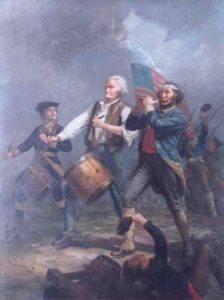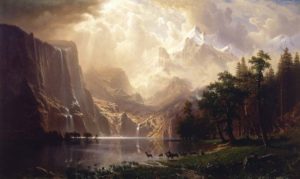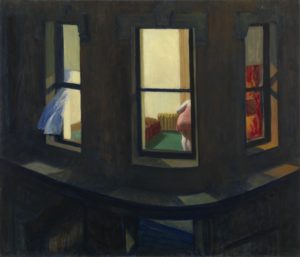ART AND POWER
GUEST ESSAY BY RICHARD REITZELL
Art and power- two words that don’t seem to naturally fit together. Power conveys a sense of influence, drama, action, and suggests a variety of intense images – the roar of rocket, waves crashing against a rocky shoreline, lightning piercing a night sky, or even the smooth muscular strides of horse racing’s recent Triple Crown champion Justified charging down the home stretch.
In contrast, for many of us, art conjures images of contemplation in a quiet museum, a flurried paint pattern of a contemporary work, or beautiful landscapes dappled with soft pastel tones that comfortably immerse us into a relaxing place or moment. And yet, throughout the annals of time and history two threads are continually evident- the power and impact of the written word and the visual image. Painting and art through the centuries have shown the persistent power to impact and influence human emotions and perceptions and to directly impact or influence a range of endeavors and events.
Let’s take a closer look…
The Power of the Cross

For many centuries in Europe the creation of art and the output of artists was almost exclusively for the benefit of the churches that dominated the daily life. In fact, most early Italian art was created exclusively around religious themes that served many purposes. Churches utilized art in magnificent altarpieces, large canvases that conveyed allegorical lessons and parables from the bible, and even used the stunning beauty of stained glass to create cathedrals that enthralled and welcomed their followers with a sense of something special. In the cathedrals and churches that were often the core of European communities, it was art that helped create a warm welcoming presence and established the visual connection between religion and its teachings. Art positioned biblical figures as real flesh and blood characters and not merely distant writings. Art contributed significantly to the magnificent splendor and all encompassing aura of the church and reinforced the power and belief in a higher power.

The Power of the Crown
The other powerful influence in the development of the western world was the presence of royalty in many countries. For generations after generations, rulers and royalty would adorn their palaces and country homes with extensive art collections gathered through commissions, conquests, or acquisitions. By commissioning major artworks that captured scenes of their kingdom and stories from the bible and mythology, they conveyed themselves in a manner that radiated a sense of importance, power, burnished their legacies, and further extended their influence. These vast collections, including the massive collection of Napoleon, became the foundation of the Louvre, the world’s largest and most famous museum. The often immense, neo-classical paintings exuded power as they commemorated coronations and other royal events, celebrated great battlefield victories, captured the drama of foreign travels, documented meetings with dignitaries, and generally portrayed the monarchs and their families with near-mythological relevance. Perhaps no stronger example of the power of art to embellish an image is the twenty-four immense Medici Cycle murals that fill a large gallery at the Louvre. Marie de’ Medici was a relatively minor player in French history whose royal connection was brief and mostly undistinguished. After returning from exile and building the Luxembourg Palace, she commissioned the noted artist Peter Paul Rubens to create twenty-four murals that glorified her life. While Rubens had few life accomplishments of Marie to work with, he created a powerful series of magnificently allegorical paintings that elevated Medici from a historical footnote to an almost mythical level.
The Power of Patriotism

While different from the deep connection of personal religious beliefs or the experience of a monarch, patriotism is an often unifying glue that bonds people of varied backgrounds under a common ideal. Paintings may powerfully convey a national theme or become a living emblem of a patriotic feeling. It is hard to look at the oversized canvas of Washington Crossing the Delaware that so dramatically hangs in New York’s Metropolitan Museum of Art and not gain a sense of George Washington as a bold and courageous leader who shares the founding aspirations of the American promise. A similar feeling is evoked by Archibald Willard’s Spirit of ’76 (also known as Yankee Doodle) capturing a trio of battlefield participants playing drums and fife with a smoke-obscured flag standing tall on a battlefield of the revolution. The painting of Rosie the Riveter that now hangs at the Crystal Bridges Museum in Arkansas captures a different sense of patriotism. Portraying the wartime contributions of the everyday woman, the series of paintings communicated a powerful message of inclusion and triumph to a national audience. Another powerful image that commemorated a patriotic theme was the famous painting Liberty Leading the People by Eugene Delacroix. An inspiring work that shows Liberty leading the uprising against the French King Charles X, the painting created both the enduring image of a citizen-led uprising, but also established the image of Liberty as a powerful female.
The Power of Illumination

Whether one considers illumination in the literal sense of the glowing light, as a fascinating and alluring imagery, or a deeper reflection of opening of one’s mind to newer ideas and possibilities, there are a myriad of wonderful examples of how art provided the power of light. The beauty of illumination in William Mallard Turner’s works can only inspire those who spend a moment with his greatest masterpieces. Whether a scene from the Mediterranean, or a setting of mythological nature, Turner’s radiant sun and iridescent sky provides a wonderfully luminescent power that few can resist. In Nineteenth Century America artists like Albert Bierstadt, Thomas Moran, Fredrick Church and others created a similar sense of marvel as they captured the sense of wonderment that we felt for America’s western frontier. Symbolic of our growth as a nation and of the limitless possibilities of discovery in the uncharted magnificence of the emerging American West, the artists created powerful imagery that inspired and metaphorically added to our emerging sense of America’s greatness and limitless future.
The Power of Imagery on the Senses

This power of art may be the most obvious of all. It is fascinating to realize how stimulating and powerful layers of paint on a flat surface by the skilled hand of an artist can be. One only needs to look at later works from southern France by Vincent Van Gogh. These paintings of quiet landscapes become wildly energetic through his use of thick, bright, vibrating strokes ofpaint that convincingly express his inner turmoil and agitated state. Several series of abstract paintings from Russian artist Wassily Kandinsky convey bright colors and stimulating patterns and yet also convey visual expressions of music that merge multiple senses. American artist Edward Hopper was a master of creating quiet, serene paintings that evoked a deep sense of solitude and isolation in the viewer. A swirling storm on a dark day captured on canvas by Frenchman Maurice Vlaminck instantly alters the viewer in ways that are difficult to describe. And finally, no one through the years altered the viewer’s senses more than Pablo Picasso. Beginning in his “Blue” period, through his cubist days, continuing with his wild, distorted representations of the human form, Picasso constantly and creatively challenged our senses and our views of what is normal art and form.
The Power of Beguilement and Curiosity

Beguilement and curiosity are fascinating emotions that stimulate thought in so many ways. Who can look at Leonardo Da Vinci’s famous Mona Lisa without a sense of beguilement? The calm setting, the mesmerizing “smile”, the odd background for a portrait. The sense of engagement created in the viewer all speak to the power of art. Similar emotions are triggered when one is exposed to surrealistic art of Salvador Dali or René Magritte who created a genre that co-mingled reality and sub-conscious imagery with a strong dose of imagination. Other examples abound; the power and later desperation of German expressionism in the early twentieth century, the horror of Jewish art during World War II, the simplicity of form seen in the later art of Dutch artist Piet Mondrian, the power of altering shapes and form in the art of Paul Cezanne, the kinetic motion and rhythm of the Italian Futurists, the powerfully saturated colors of the Fauvists, and even the wild flurry of form and emotion seen in the works of Willem de Kooning’s chaotic images of the female soul
Art and Power … words that absolutely belong together!
RICHARD REITZELL is an avid art collector and author of From a Versatile Brush the Life and Art of Jean Mannheim. He is a member of the CMATO Board of Directors.
